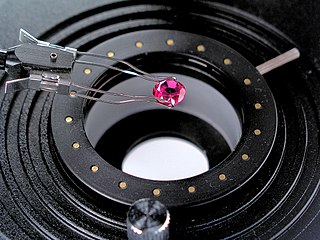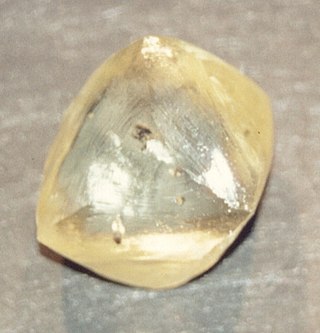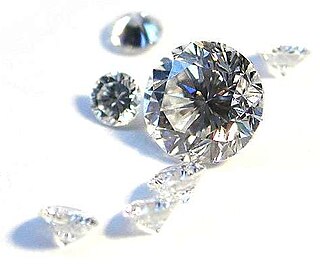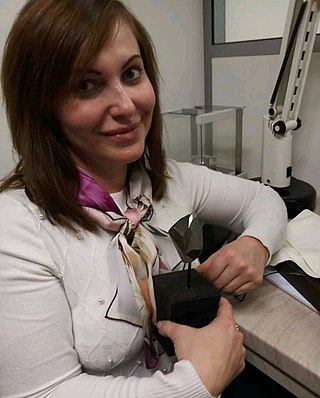
A gemstone is a piece of mineral crystal which, when cut or polished, is used to make jewelry or other adornments. Certain rocks and occasionally organic materials that are not minerals may also be used for jewelry and are therefore often considered to be gemstones as well. Most gemstones are hard, but some softer minerals such as brazilianite may be used in jewelry because of their color or luster or other physical properties that have aesthetic value. However, generally speaking, soft minerals are not typically used as gemstones by virtue of their brittleness and lack of durability.

Ruby is a pinkish red to blood-red colored gemstone, a variety of the mineral corundum. Ruby is one of the most popular traditional jewelry gems and is very durable. Other varieties of gem-quality corundum are called sapphires. Ruby is one of the traditional cardinal gems, alongside amethyst, sapphire, emerald, and diamond. The word ruby comes from ruber, Latin for red. The color of a ruby is due to the element chromium.

Gemology or gemmology is the science dealing with natural and artificial gemstone materials. It is a specific interdisciplinary branch of mineralogy. Some jewelers are academically trained gemologists and are qualified to identify and evaluate gems.

Tanzanite is the blue and violet variety of the mineral zoisite, caused by small amounts of vanadium. Tanzanite belongs to the epidote mineral group. Tanzanite is only found in Simanjiro District of Manyara Region in Tanzania, in a very small mining area approximately 7 km (4.3 mi) long and 2 km (1.2 mi) wide near the Mererani Hills.
Diamond clarity is the quality of diamonds that relates to the existence and visual appearance of internal characteristics of a diamond called inclusions, and surface defects, called blemishes. Clarity is one of the four Cs of diamond grading, the others being carat, color, and cut.

A chemically pure and structurally perfect diamond is perfectly transparent with no hue, or color. However, in reality almost no gem-sized natural diamonds are absolutely perfect. The color of a diamond may be affected by chemical impurities and/or structural defects in the crystal lattice. Depending on the hue and intensity of a diamond's coloration, a diamond's color can either detract from or enhance its value. For example, most white diamonds are discounted in price when more yellow hue is detectable, while intense pink diamonds or blue diamonds can be dramatically more valuable. Of all colored diamonds, red diamonds are the rarest. The Aurora Pyramid of Hope displays a spectacular array of naturally colored diamonds, including red diamonds.
Diamond enhancements are specific treatments, performed on natural diamonds, which are designed to improve the visual gemological characteristics of the diamond in one or more ways. These include clarity treatments such as laser drilling to remove black carbon inclusions, fracture filling to make small internal cracks less visible, color irradiation and annealing treatments to make yellow and brown diamonds a vibrant fancy color such as vivid yellow, blue, or pink.

The Gemological Institute of America (GIA) is a nonprofit institute based in Carlsbad, California. It is dedicated to research and education in the field of gemology and the jewelry arts. Founded in 1931, GIA's mission is to protect buyers and sellers of gemstones by setting and maintaining the standards used to evaluate gemstone quality. The institute does so through research, gem identification, diamond grading services, and a variety of educational programs. Through its library and subject experts, GIA acts as a resource of gem and jewelry information for the trade, the public and media outlets.

The American Gem Society (AGS) is a trade association of retail jewelers, independent appraisers, suppliers, and selective industry members, which was founded in 1934 by Robert M. Shipley.
Accreditation is the independent, third-party evaluation of a conformity assessment body against recognised standards, conveying formal demonstration of its impartiality and competence to carry out specific conformity assessment tasks.

Diamonds were largely inaccessible to investors until the recent advent of regulated commodities, due to a lack of price discovery and transparency. The characteristics of individual diamonds, especially the carat weight, color and clarity, have significant impact on values, but transactions were always private. With the standardized commodity as an underlying asset, several market traded financial instruments have been announced.
The Asian Institute of Gemological Sciences (AIGS) is a private gemological school and gemological laboratory based in Bangkok, Thailand.

Diamond is a gemstone formed by cutting a raw diamond. Diamonds are one of the best-known and most sought-after gems, and they have been used as decorative items since ancient times.
International Gemological Institute (IGI) is a Belgian diamond, colored stone and jewelry certification organization. Established in 1975, it is the largest independent gemological laboratory worldwide.
The Gemmological Association of Great Britain (Gem-A) is an international gemmology education and qualifications body based in the United Kingdom.
Richard T. Liddicoat, Jr. was an American gemologist. An educator in gemology, he contributed in the area of diamond quality grading and gem identification. Liddicoat was the Chairman of the Board of Governors at the Gemological Institute of America (GIA).
The German Gemmological Association (DGemG) is a nonprofit, technical-scientific association in the field of gemmology, located in the European gemstone center Idar-Oberstein. The two most important points of the statutes are the promotion of gemmology as science and technique and the development of information and education in the field of gemmology.

Gemological Science International, or GSI, is an independent gemological organization that is one of the largest gemological entities in the world, with offices in four continents.

Sarine Technologies Ltd is a publicly traded company that develops, produces and sells technologies for the diamond industry, including devices for the planning, analysis and grading of rough and polished diamonds. Company headquarters are located in Hod Hasharon, Israel. The company operates subsidiaries in Dalton, Israel, India, New York and Hong Kong. In 2017, Sarin India, the Indian subsidiary, opened “Sarin House” in Surat, consolidating the company's Surat-based activities in one facility.

Larisa Popova is an Italian gemologist, appraiser and jeweler.











